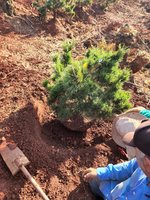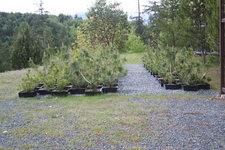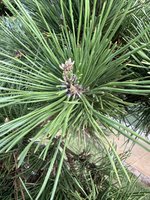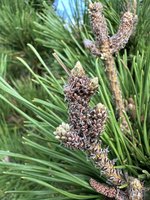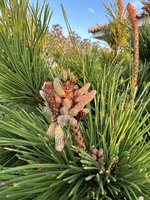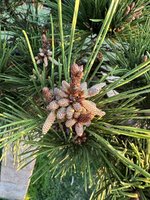Another update.
This tree is a fighter... Dug up from the field at 14 july and after 3 and 1/2 months in the first week of november we had a tropical storm at my farm at 2:00 AM. We sometimes get stronger winds, a few times something smaller that i don't care too much dropped from my benches, but never had anything as strong as that night happen, this storm had winds over 80 mph... 1 bench got knocked over, but no damage at all for my smaller sized trees, i never tought that this pine, with it's heavy weight was going get knocked over from the bench, well... i was wrong.
When it dropped from my bench, the plastic container broke in pieces and the wind blowed the tree around like a paper bag, when the storm stopped around 3:30 AM i got out to check the damages and i could not find this tree, so with a flashlight at hand i started searching and i kid you not, i found it 80 meters away from my bench UPWARDS a small hill on my yard stucked at my fence. Essentialy, with all the wind, heavy rain, and who knows how much rolling around my yard, the tree bare rooted itself, probably better than i could ever do, it had literally no soil on the roots, washed clean, with only roots left... this being my most cherished and expensive tree, the first tree that i dug out myself, i entered in panic mode and forgot to take any pictures... luckily i had stored substrate already mixed and ready to use and a wooden box that i was going to use on a jabuticaba yamadori that same week, and at around 4:00 AM after assessing the situation i proceeded with an emergency repot of what was left from the roots, anchored the tree at the box much better than before and top dressed with sphagnum. Some longer branches broke, so i cut them clean and applied cut paste.
For aftercare, i left it on the bench in full sun, kept misting as much as i could for the first month, fertilized using organics mixed with osmocote on teabags, kept on top of my watering, only using water from my tilapia farm and applied 1x per week fish and kelp emulsion.
Today it's been around 3 months since the emergency repot, we are currently in mid summer, with temperatures ranging from 25 to 36 Celcius... So after being dug out from the field, having the roots worked, then bare rooted / repoted again in the span of 7 months, im happy to say that i think it's ok.
Since the emergency repot it has backbudded profusely all around, new needles emerging / growing and several roots showing at the bottom of the box, it appears to never have skipped a beat.
Things i learned:
1º Tie down your valued trees, ESPECIALLY the big ones.
2º These trees are stronger than it looks.
3º maybe barerooting is not that bad?
I took the following picutres today.






































